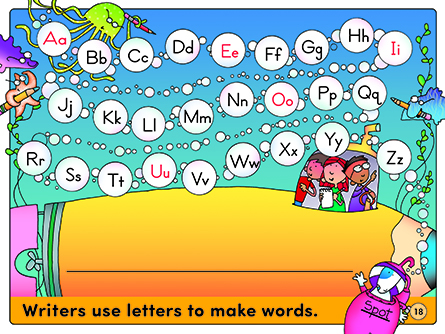Additional Activities
These activities offer options for continuing the learning in this unit. Whether your curriculum is skill-based or more open-ended, select the activities that are most appropriate for the children in your classroom. The Writing Spot is primarily a writing program, but writing can be integrated throughout your curriculum—in art, drama, reading, math, and science.
-
Add words to an A-B-C sentence frame.
Write a simple sentence, like this one, on the board: "The______ sneezed, and the _______ ran away." As a class, invite children to fill in the blanks with words that begin with “A,” “B,” “C,” and so on. Encourage children to illustrate some of the silly sentences. Use "ABC’s" for this activity.
-
Use letters to make words.
Using correct letters and sounds to write “real” words can be a scary transition for some children. This is when the child who has enjoyed the more spontaneous form of writing could lose interest. It is important to schedule two kinds of writing time, one to practice the mechanics of writing and the other to incorporate individuality. As children learn conventional spelling of words, they will add them to their writing.
-
Talk about words as writers’ tools.
Talk with children about the importance of words. Explain that along with ideas, words are the most important tools that writers use. Without words, there would be no stories, no notes and cards, no signs or books. Without words, people would have a difficult time communicating. Ask children to look around the room and find places or things that have words.
As children understand how to combine letters to make simple C-V-C words (sit, sat), give them building materials—individual letter cards, alphabet blocks, magnetic letters, and so on. Make a bulletin board containing the outline of a building, and have the children fill it with words they have “built.”
Writers move words around to see how they best fit together to convey a specific idea. Children can move letters around to create new words. Try this group activity with large alphabet cards (each containing one letter). Each child is given a card. Help the children to stand in groups, holding up their letters to create words. Show them how to move around to create new words: “cat” becomes “bat,” “bat” becomes “hat,” and so on. Once children understand the game, let them find their own letter buddies and form new words.
Have a rhyming day. Read rhymes, sing rhymes, and talk in rhyme. Give children written models to illustrate how rhyming words are alike and how they are different. Allow children to build rhyming words from a set of letters that you provide. Encourage children to write rhymes in their journals and on notes and cards.
-
Use letters and sounds to make “word stew.”
Play this game when children are confident about the sounds letters make. Children say a word and then say its beginning letter and sound. If they correctly identify the letter and sound, the word is written on the board as an ingredient for the stew. All ingredients are welcome.
